INFINITI QX60 HYBRID 2015 Dismantling Guide
Manufacturer: INFINITI, Model Year: 2015, Model line: QX60 HYBRID, Model: INFINITI QX60 HYBRID 2015Pages: 49, PDF Size: 3.21 MB
Page 21 of 49
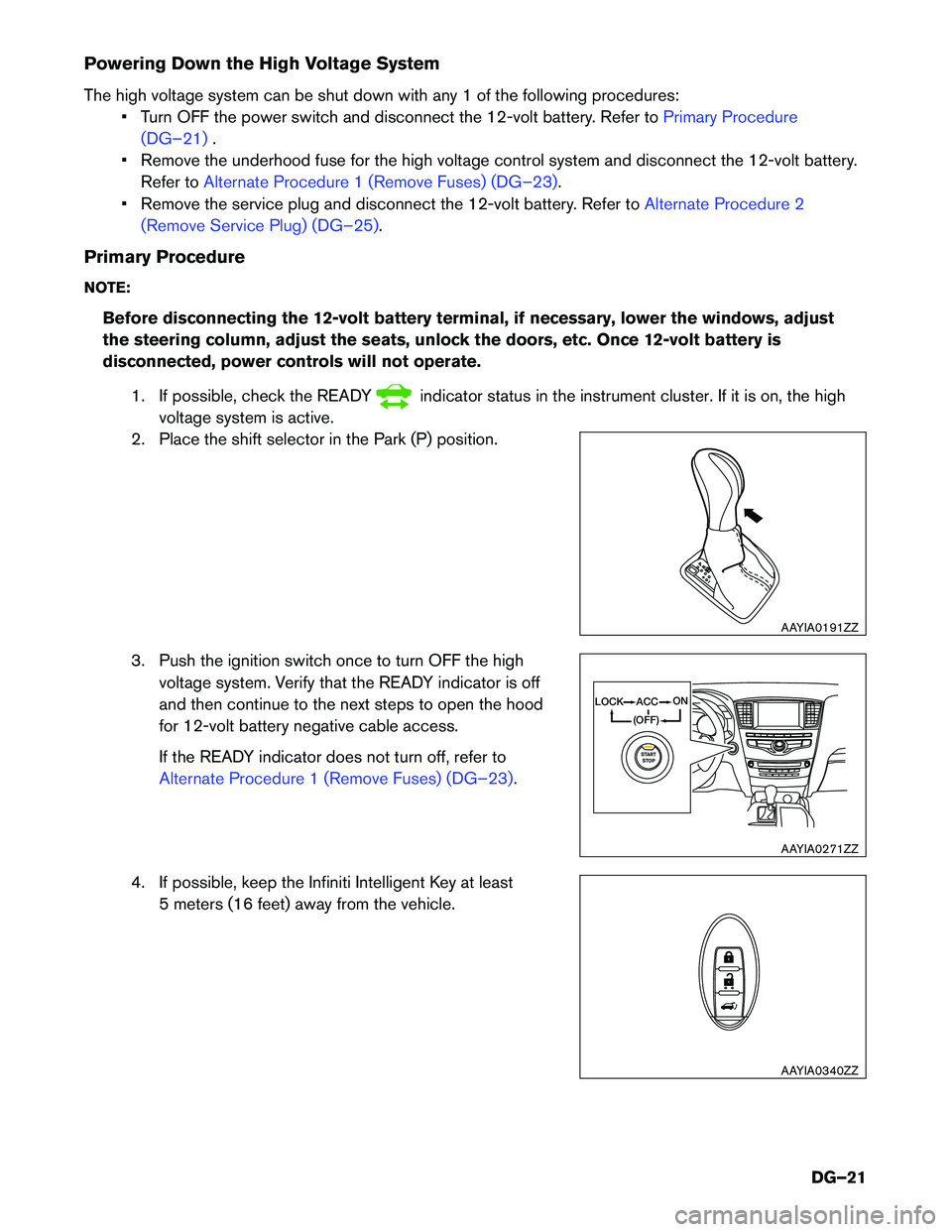
Powering Down the High Voltage System
The high voltage system can be shut down with any 1 of the following procedures:• Turn OFF the power switch and disconnect the 12-volt battery. Refer to
Primary Procedure
(DG–21)
.
• Remove the underhood fuse for the high voltage control system and disconnect the 12-volt battery. Refer to
Alternate Procedure 1 (Remove Fuses) (DG–23).
• Remove the service plug and disconnect the 12-volt battery. Refer to
Alternate Procedure 2
(Remove Service Plug) (DG–25)
.
Primary Procedure
NOTE: Before disconnecting the 12-volt battery terminal, if necessary, lower the windows, adjust
the steering column, adjust the seats, unlock the doors, etc. Once 12-volt battery is
disconnected, power controls will not operate.
1. If possible, check the READY
indicator status in the instrument cluster. If it is on, the high
voltage system is active.
2. Place the shift selector in the Park (P) position.
3. Push the ignition switch once to turn OFF the high voltage system. Verify that the READY indicator is off
and then continue to the next steps to open the hood
for 12-volt battery negative cable access.
If the READY indicator does not turn off, refer to
Alternate Procedure 1 (Remove Fuses) (DG–23).
4. If possible, keep the Infiniti Intelligent Key at least 5 meters (16 feet) away from the vehicle.
AAYIA0191ZZ
ACC
LOCK
(OFF)
ON
AAYIA0271ZZ
AAYIA0340ZZ
DG–21
Page 22 of 49
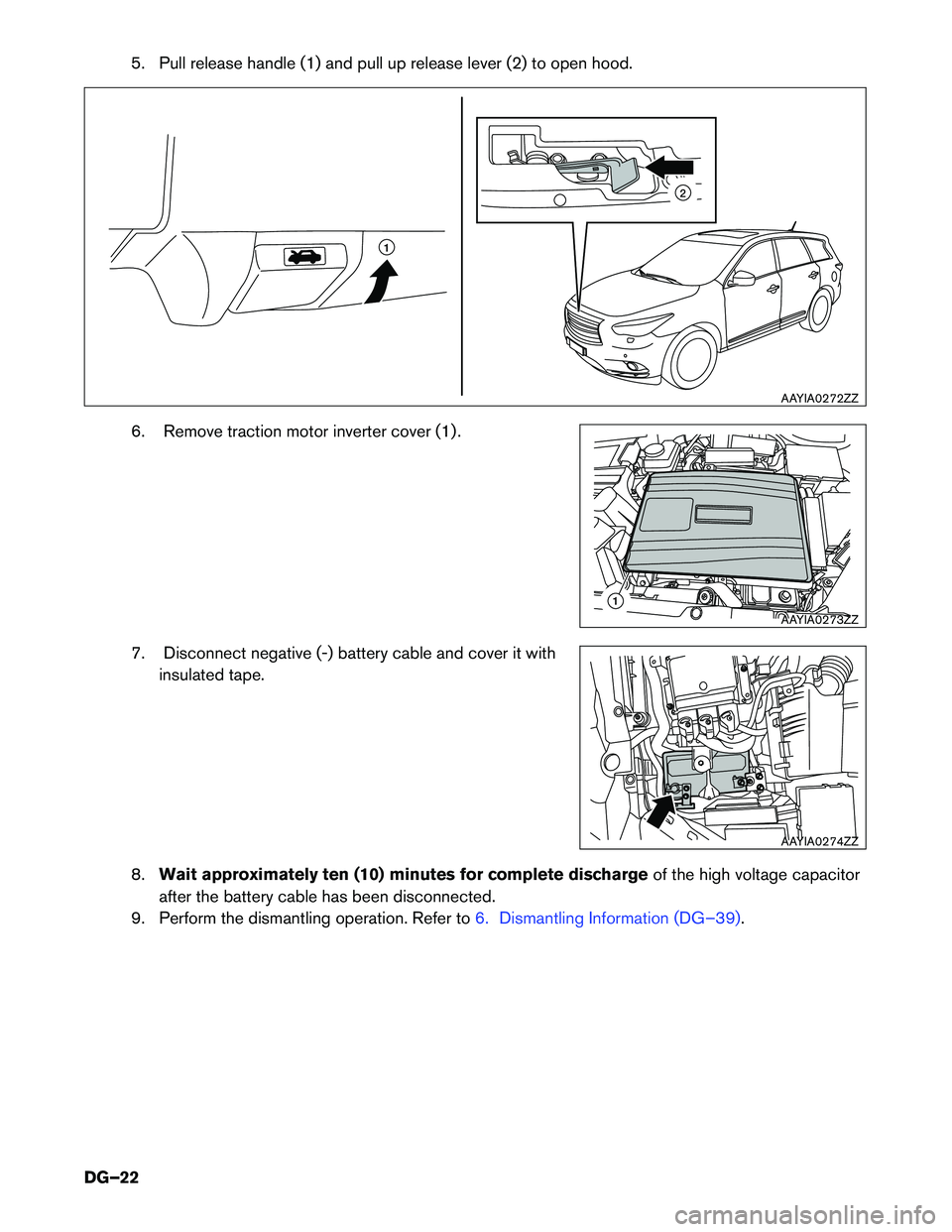
5. Pull release handle (1) and pull up release lever (2) to open hood.
6. Remove traction motor inverter cover (1) .
7. Disconnect negative (-) battery cable and cover it withinsulated tape.
8. Wait approximately ten (10) minutes for complete discharge of the high voltage capacitor
after the battery cable has been disconnected.
9. Perform the dismantling operation. Refer to
6. Dismantling Information (DG–39).
1
2
AAYIA0272ZZ
1
AAYIA0273ZZ
AAYIA0274ZZ
DG–22
Page 23 of 49
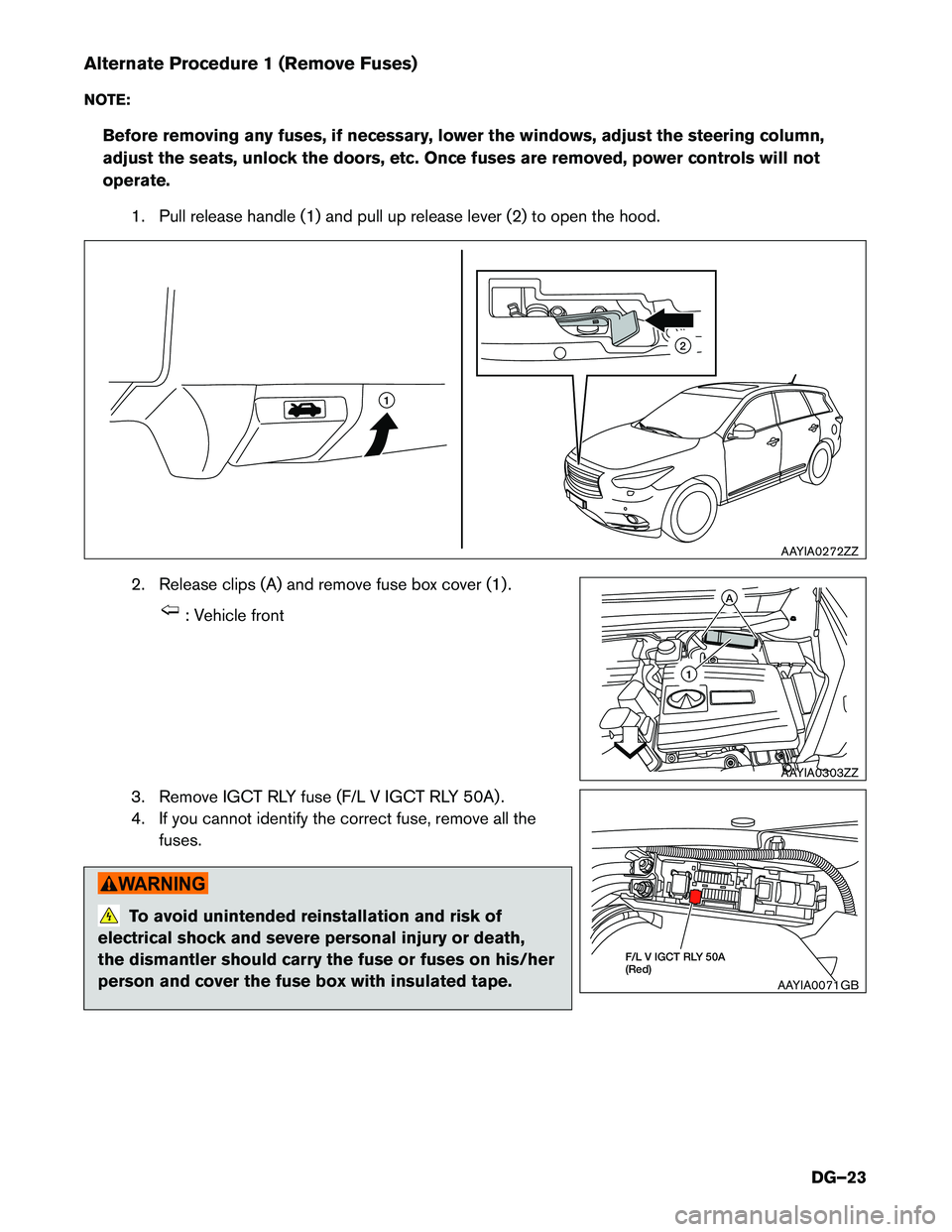
Alternate Procedure 1 (Remove Fuses)
NOTE:Before removing any fuses, if necessary, lower the windows, adjust the steering column,
adjust the seats, unlock the doors, etc. Once fuses are removed, power controls will notoperate. 1. Pull release handle (1) and pull up release lever (2) to open the hood.
2. Release clips (A) and remove fuse box cover (1) .
: Vehicle front
3. Remove IGCT RLY fuse (F/L V IGCT RLY 50A) .
4. If you cannot identify the correct fuse, remove all the fuses.
To avoid unintended reinstallation and risk of
electrical shock and severe personal injury or death,
the dismantler should carry the fuse or fuses on his/her
person and cover the fuse box with insulated tape.
1
2
AAYIA0272ZZ
1
A
AAYIA0303ZZ
F/L V IGCT RLY 50A (Red)
AAYIA0071GB
DG–23
Page 24 of 49
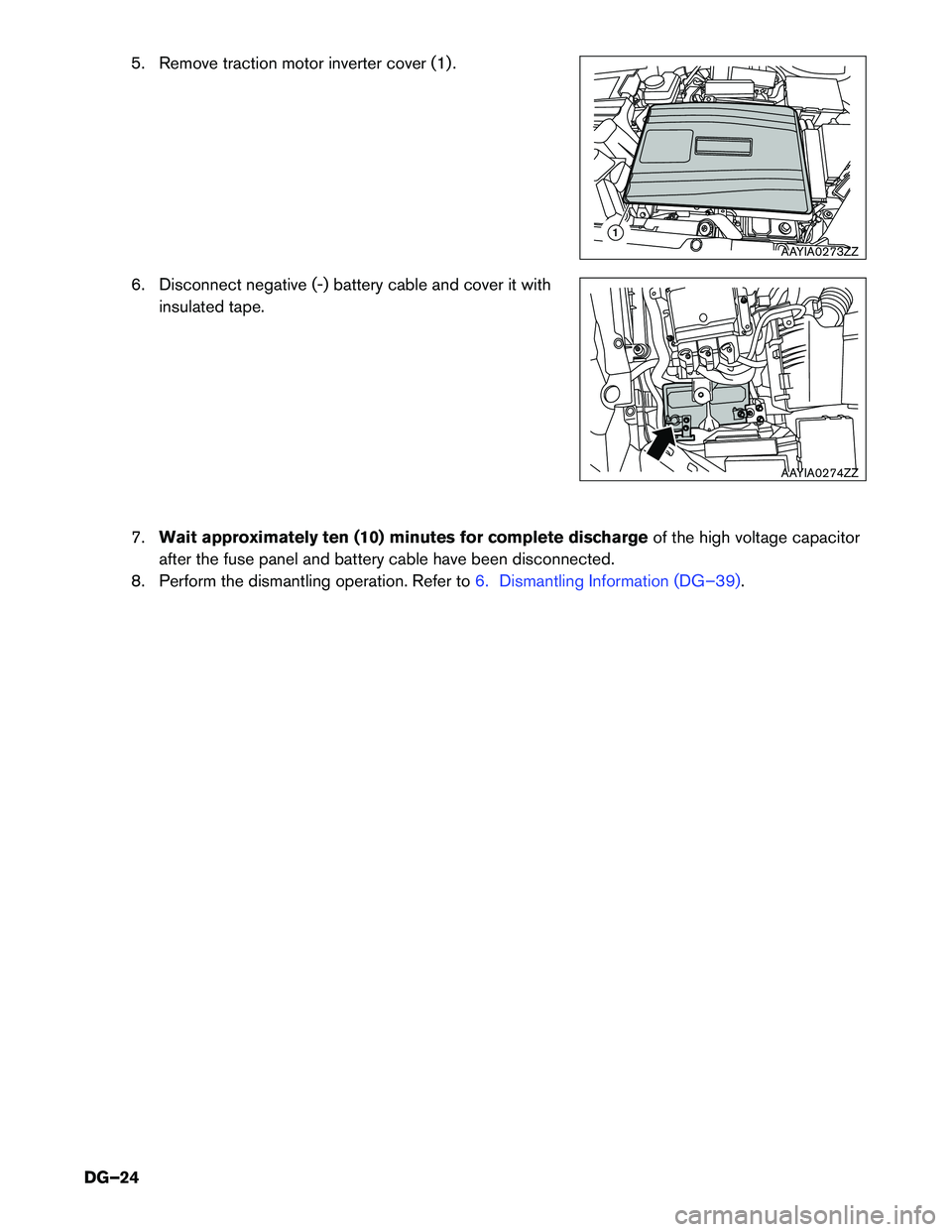
5. Remove traction motor inverter cover (1) .
6. Disconnect negative (-) battery cable and cover it withinsulated tape.
7. Wait approximately ten (10) minutes for complete discharge of the high voltage capacitor
after the fuse panel and battery cable have been disconnected.
8. Perform the dismantling operation. Refer to
6. Dismantling Information (DG–39).
1
AAYIA0273ZZ
AAYIA0274ZZ
DG–24
Page 25 of 49
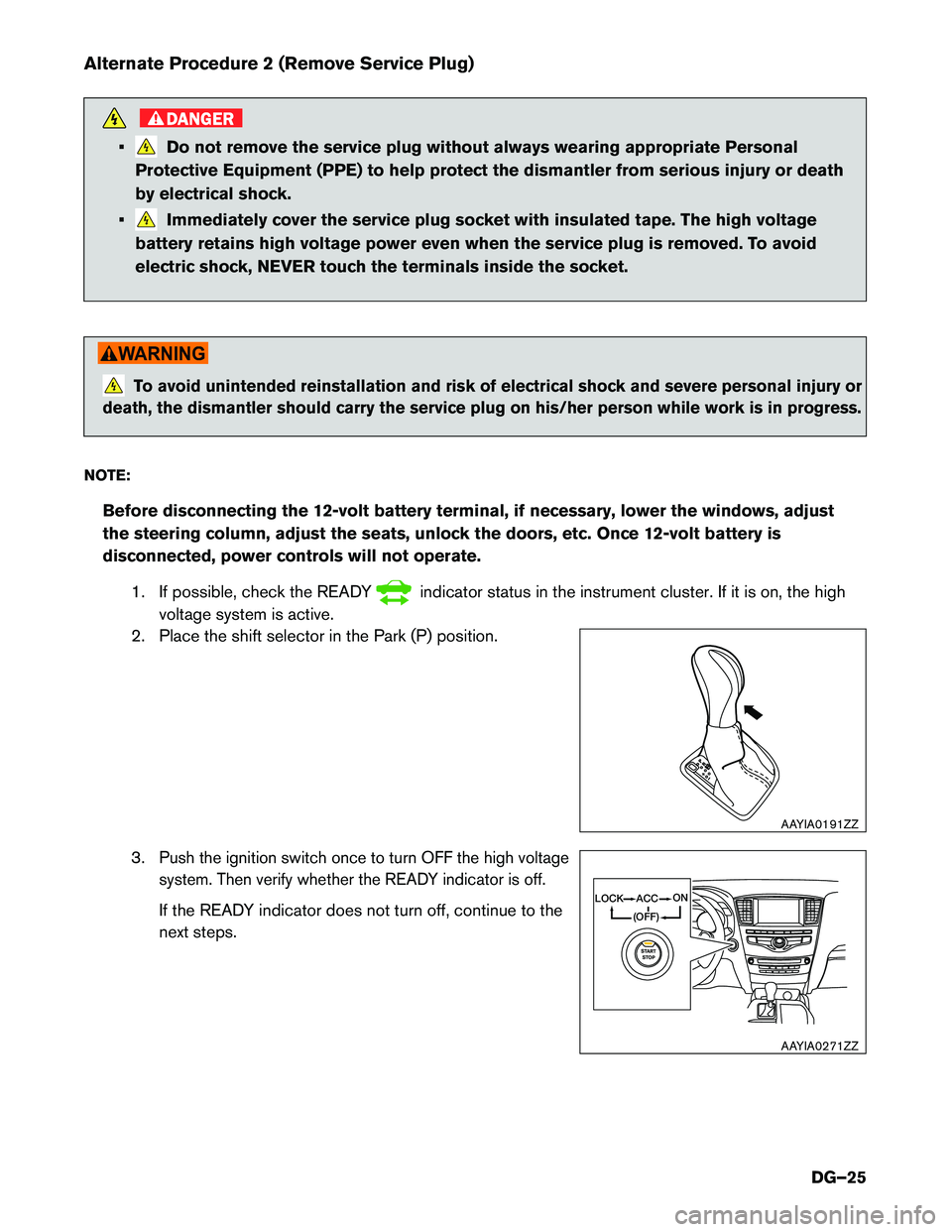
Alternate Procedure 2 (Remove Service Plug)
DANGER
•Do not remove the service plug without always wearing appropriate Personal
Protective Equipment (PPE) to help protect the dismantler from serious injury or death
by electrical shock.
•
Immediately cover the service plug socket with insulated tape. The high voltage
battery retains high voltage power even when the service plug is removed. To avoid
electric shock, NEVER touch the terminals inside the socket.
To avoid unintended reinstallation and risk of electrical shock and severe personal injury or
death, the dismantler should carry the service plug on his/her person while work is in progress.
NOTE:
Before disconnecting the 12-volt battery terminal, if necessary, lower the windows, adjust
the steering column, adjust the seats, unlock the doors, etc. Once 12-volt battery is
disconnected, power controls will not operate. 1. If possible, check the READY
indicator status in the instrument cluster. If it is on, the high
voltage system is active.
2. Place the shift selector in the Park (P) position. 3.
Push the ignition switch once to turn OFF the high voltage
system. Then verify whether the READY indicator is off.
If the READY indicator does not turn off, continue to the
next steps.
AAYIA0191ZZ
ACC
LOCK
(OFF)
ON
AAYIA0271ZZ
DG–25
Page 26 of 49
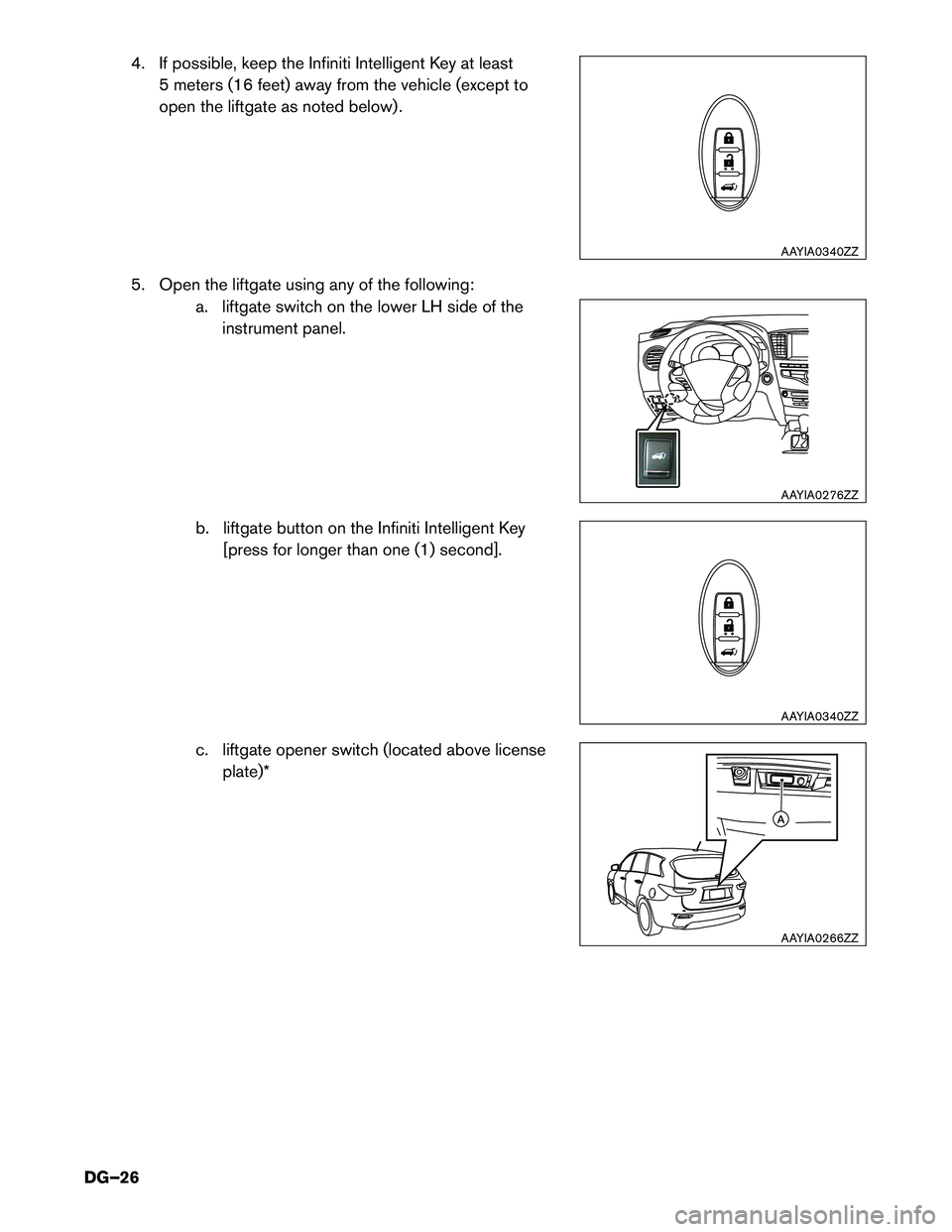
4. If possible, keep the Infiniti Intelligent Key at least5 meters (16 feet) away from the vehicle (except to
open the liftgate as noted below) .
5. Open the liftgate using any of the following: a. liftgate switch on the lower LH side of theinstrument panel.
b. liftgate button on the Infiniti Intelligent Key [press for longer than one (1) second].
c. liftgate opener switch (located above license plate)*
AAYIA0340ZZ
AAYIA0276ZZ
AAYIA0340ZZ
A
AAYIA0266ZZ
DG–26
Page 27 of 49
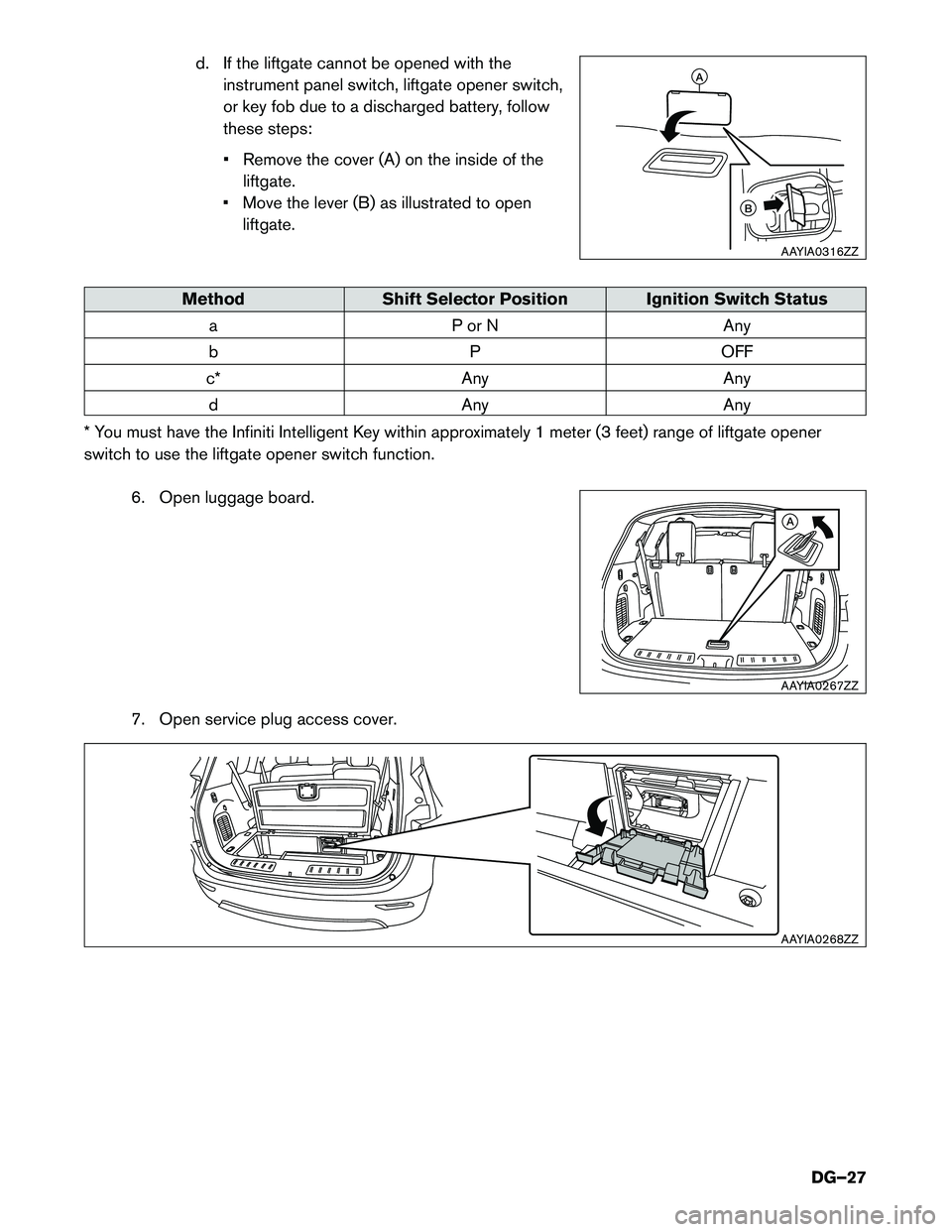
d. If the liftgate cannot be opened with theinstrument panel switch, liftgate opener switch,
or key fob due to a discharged battery, follow
these steps:
• Remove the cover (A) on the inside of the
liftgate.
• Move the lever (B) as illustrated to open liftgate.
Method Shift Selector Position Ignition Switch Status
a P or N Any
b P OFF
c* Any Any d Any Any
* You must have the Infiniti Intelligent Key within approximately 1 meter (3 feet) range of liftgate opener
switch to use the liftgate opener switch function.
6. Open luggage board.
7. Open service plug access cover.
A
B
AAYIA0316ZZ
A
AAYIA0267ZZ
AAYIA0268ZZ
DG–27
Page 28 of 49
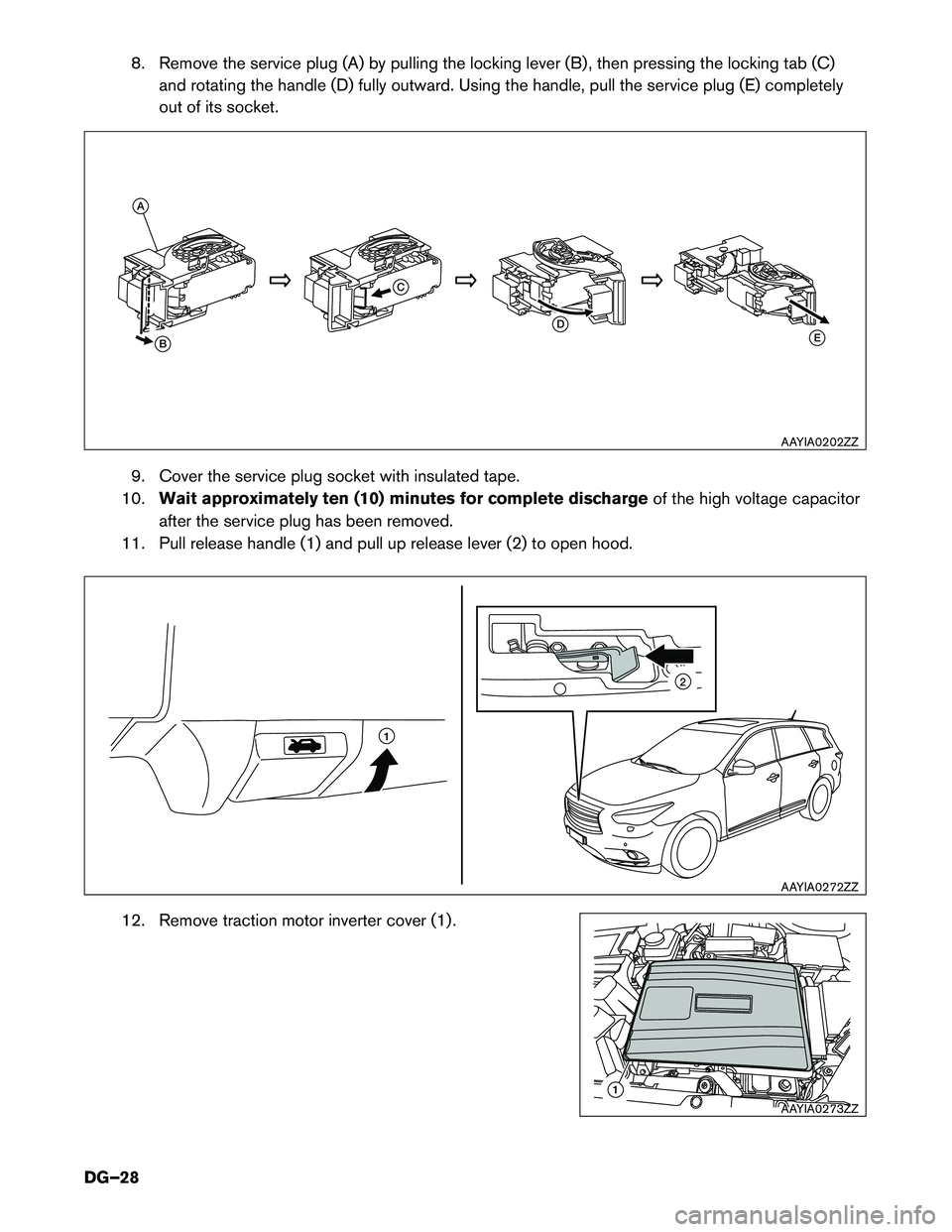
8. Remove the service plug (A) by pulling the locking lever (B) , then pressing the locking tab (C)and rotating the handle (D) fully outward. Using the handle, pull the service plug (E) completely
out of its socket.
9. Cover the service plug socket with insulated tape.
10. Wait approximately ten (10) minutes for complete discharge of the high voltage capacitor
after the service plug has been removed.
11. Pull release handle (1) and pull up release lever (2) to open hood.
12. Remove traction motor inverter cover (1) .
A
B
C
DE
AAYIA0202ZZ
1
2
AAYIA0272ZZ
1
AAYIA0273ZZ
DG–28
Page 29 of 49
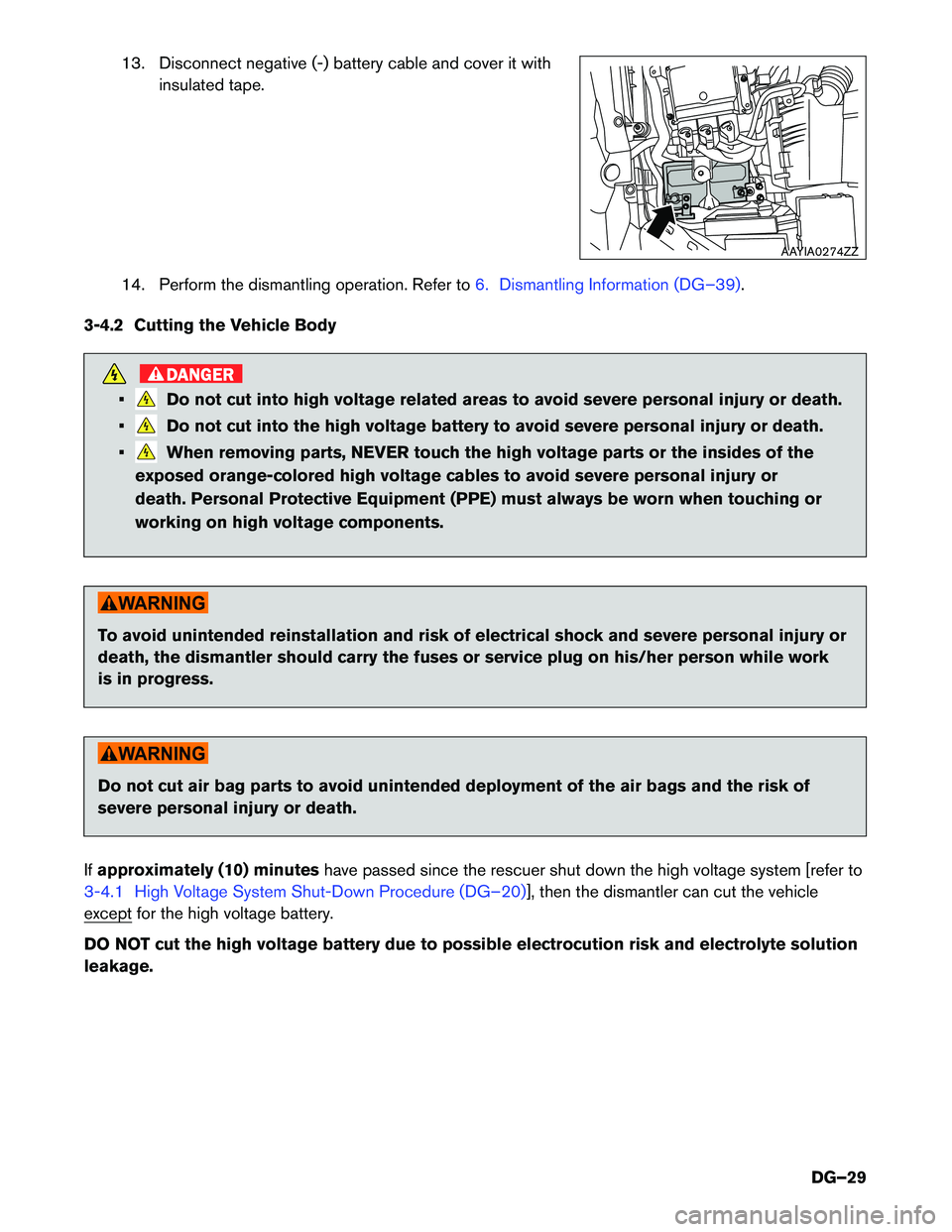
13. Disconnect negative (-) battery cable and cover it withinsulated tape.
14. Perform the dismantling operation. Refer to
6. Dismantling Information (DG–39).
3-4.2 Cutting the Vehicle Body
DANGER
•Do not cut into high voltage related areas to avoid severe personal injury or death.
•
Do not cut into the high voltage battery to avoid severe personal injury or death.
•
When removing parts, NEVER touch the high voltage parts or the insides of the
exposed orange-colored high voltage cables to avoid severe personal injury or
death. Personal Protective Equipment (PPE) must always be worn when touching or
working on high voltage components.
To avoid unintended reinstallation and risk of electrical shock and severe personal injury or
death, the dismantler should carry the fuses or service plug on his/her person while work
is in progress.
Do not cut air bag parts to avoid unintended deployment of the air bags and the risk of
severe personal injury or death.
If approximately (10) minutes have passed since the rescuer shut down the high voltage system [refer to
3-4.1 High Voltage System Shut-Down Procedure (DG–20)], then the dismantler can cut the vehicle
except for the high voltage battery.
DO NOT cut the high voltage battery due to possible electrocution risk and electrolyte solution leakage.
AAYIA0274ZZ
DG–29
Page 30 of 49

SRS Air Bag System Components Location
The SRS air bag system must not be cut as there is a risk of short circuit and unintentional deployment of
the SRS. However, the vehicle can be cut (except inflators) under the following conditions:• The front, side and curtain air bags have deployed.
• At least three (3) minutes have passed after the 12-volt battery negative (-) cable has beendisconnected and the high voltage system has been shut down.
1. Roof-mounted curtain side-
impact and rollover supplemental
air bag inflators 2. Air bag control unit (ACU) 3. Supplemental front-impact air
bag modules
4. Pressure sensors (driver’s side
door shown; passenger side doorsimilar) 5. Crash zone sensor 6. Satellite sensors (RH shown,
LH similar)
7. Front seat-mounted side-
impact supplemental air bags 8. B-pillar satellite sensors
(RH shown, LH similar)9. Seat belts with pretensioners
10. Occupant classification
sensors (weight sensors –
located on passenger seat frame) 11. Occupant classification
system control unit
12
345
1110987
6
AAYIA0282ZZ
DG–30